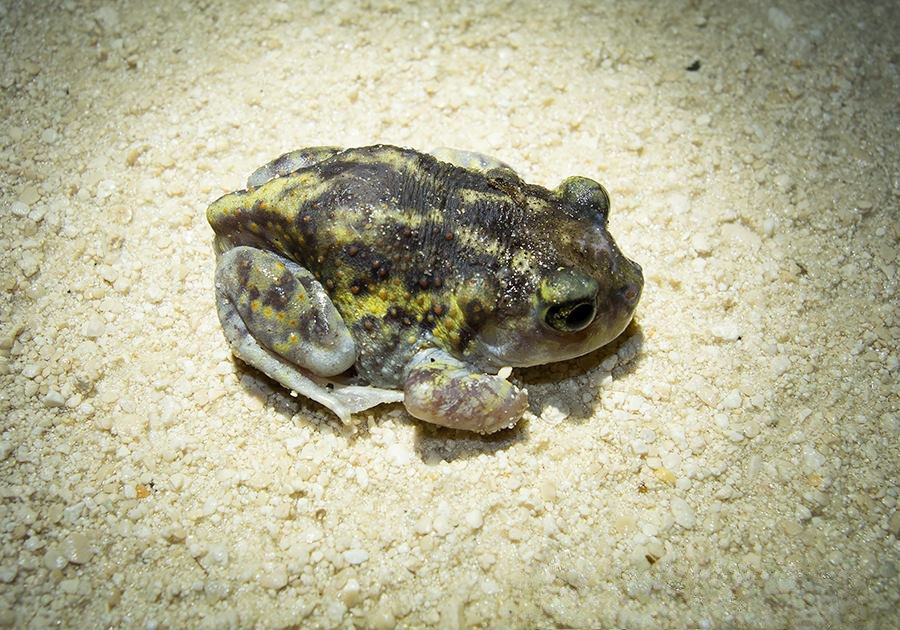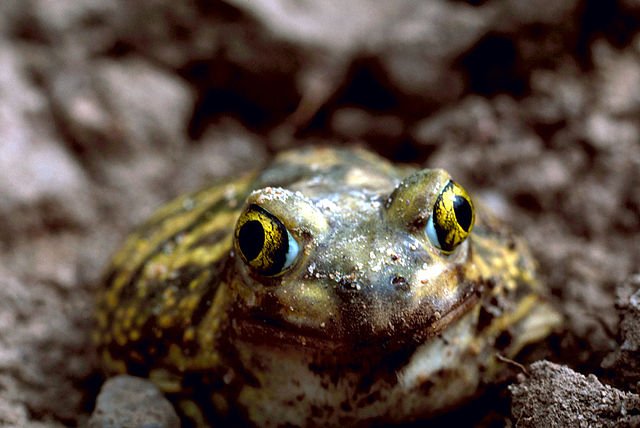Sand Between Your Toads
“Western Spadefoot Toad” by Chris Brown (USGS/WERC) is licensed under Public Domain
Scaphiopodidae
by Inspector Barry Mins on January 3, 2023Hey kids, welcome back to our series on the mysteries of created kinds. Last week, we met a loud, colorful bird kind. This week, we’re moving into the desert, looking for a kind of toad.

Hey kids, welcome back to our series on the mysteries of created kinds. Last week, we met a loud, colorful bird kind. This week, we’re moving into the desert, looking for a kind of toad.
The above statement may sound strange. After all, amphibians need to stay wet to live and deserts are defined by their lack of water. However, some species of these little toads have special adaptations to make them suited to desert life.1 They live in burrows dug with their special spade-shaped feet that help keep them out of the sun. They do not dry out easily, and if the tadpoles sense the water in their pond is evaporating, they speed up their development.2 They exhibit a trait called phenotypic plasticity, where various aspects of development can be altered in response to environmental conditions.3 Males and females are roughly the same size, and breeding varies throughout the year.4 Females tend to prefer more brightly colored males, perhaps because the bright colors are better camouflaged against the desert sand.5
Has anyone figured it out yet? This week’s kind is the Scaphiopodidae—the spadefoot toad kind. If you live in the American Southwest or Central America, you may have some of these near you. Stay tuned for next week when we start looking for a family of Central and South American birds.
Try out this fun crossword!
Clue
Your clue for the week is:
These birds get their name from their elaborate mating rituals where males compete for the attention of females.
Ask a Question
Have you ever had a question about created kinds but didn’t know who to ask? Have you ever wanted to learn more about your favorite kind? Well, now you can! You can ask me, Inspector Barry Mins, a question! Have your parents help you fill out this form, and you might get your question answered in my column! If you have any questions about created kinds, feel free to send them my way!
Footnotes
- There are two genera and several species of spadefoot toads, and some of them also live in swamps and in forests in the eastern US and the Northwest US, with some even as far north as British Columbia (Canada).
- R. J. Denver, N. Mirhadi, and M. Phillips, “Adaptive Plasticity in Amphibian Metamorphosis: Response of Scaphiopus hammondii Tadpoles to Habitat Desiccation,” Ecology 79, no. 6 (1998): 1859–1872.
- D. W. Pfennig, K. S. Pfennig, I. M. Ehrenreich, F. Seidl, N. A. Levis, and R. Schell, “Genome of Spea multiplicata, a Rapidly Developing, Phenotypically Plastic, and Desert-Adapted Spadefoot Toad,” G3 Genes, Genomes, Genetics 9, no. 12 (2019): 3909–3919.
- S. R. Goldberg, “Notes on Reproduction of Hurter’s Spadefoot Toads, Scaphiopus hurterii (Anura: Scaphiopodidae), from Oklahoma,” Bulletin of the Chicago Herpetological Society 54, no. 1 (2019): 9–11.
- K. S. Pfennig and T. Vásquez, “Looking on the bright side: females prefer coloration indicative of male size and condition in the sexually dichromatic spadefoot toad, Scaphiopus couchii,” Behavioral Ecology and Sociobiology 62 (2007): 127–135.
- © 2024 Answers in Genesis
- Privacy Policy
- Contact
- About


